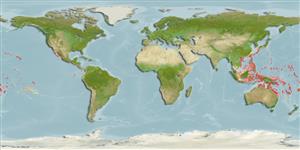>
Eupercaria/misc (Various families in series Eupercaria) >
Labridae (Wrasses) > Corinae
Etymology: Stethojulis: Greek, stetho, stethion = brest; literal = to prick a little breast + Greek, ioulis, a fish dealing with genera Coris or Thalassoma (Ref. 45335).
More on authors: Quoy & Gaimard.
Environment: milieu / climate zone / depth range / distribution range
นิเวศวิทยา
เกี่ยวกับทะเล,น้ำเค็ม เกี่ยวกับหินโสโครก; ระดับความลึก ? - 22 m (Ref. 86689). Tropical
Eastern Central Pacific: Hawaiian Islands and Johnston Island.
ขนาด / น้ำหนัก / Age
Maturity: Lm ? range ? - ? cm
Max length : 15.0 cm TL เพศผู้/กระเทย; (Ref. 86689)
Benthopelagic (Ref. 58302). Common in shallow water (maximum 22 m), over sand and lagal covered rocks; observed to take quick, seemingly indiscrimate bites of the substratum with sand emitted from its gills (Ref. 86689). Feeds primarily on bivalves, polychaete worms, peanut worms, gastropods, various small crustaceans and foraminiferans (Ref. 3921).
Life cycle and mating behavior
วัยเจริญพันธุ์ | การสืบพันธุ์ | การวางไข่ | เซลสืบพันธ์ของเพศเมีย(ไข่) | ความดกของไข่ | ตัวอ่อน
Oviparous, distinct pairing during breeding (Ref. 205).
Randall, J.E., 2007. Reef and shore fishes of the Hawaiian Islands. Sea Grant College Program, University of Hawai'i, Honolulu. i-xivb + 1-546. (Ref. 86689)
IUCN Red List Status (Ref. 130435: Version 2024-1)
Threat to humans
Harmless
Human uses
การประมง: การค้า; สถานที่แสดงสัตว์และพืชน้ำ: การค้า
เครื่องมือ
Special reports
Download XML
แหล่งที่มาจากอินเตอร์เน็ต
Estimates based on models
Preferred temperature (Ref.
123201): 24.6 - 29.3, mean 28.3 °C (based on 1606 cells).
Phylogenetic diversity index (Ref.
82804): PD
50 = 0.5010 [Uniqueness, from 0.5 = low to 2.0 = high].
Bayesian length-weight: a=0.00977 (0.00438 - 0.02182), b=3.07 (2.90 - 3.24), in cm total length, based on LWR estimates for this Genus-body shape (Ref.
93245).
ระดับชั้นอาหาร (Ref.
69278): 3.5 ±0.3 se; based on diet studies.
ความสามารถในการกลับคืนสู่ปกติ (Ref.
120179): ความสูง, เวลาต่ำสุดที่จะทำให้ประชากรเพิ่มขึ้นเป็น 2 เท่าใช้เวลาน้อยกว่า 15 เดือน (Preliminary K or Fecundity.).
Fishing Vulnerability (Ref.
59153): Low vulnerability (10 of 100).
Nutrients (Ref.
124155): Calcium = 90.9 [54.2, 155.8] mg/100g; Iron = 0.73 [0.42, 1.36] mg/100g; Protein = 18.5 [15.7, 20.7] %; Omega3 = 0.147 [0.093, 0.234] g/100g; Selenium = 20.2 [11.8, 37.3] μg/100g; VitaminA = 148 [46, 547] μg/100g; Zinc = 1.75 [1.20, 2.77] mg/100g (wet weight);
